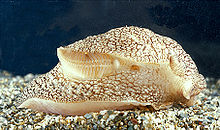- Notaspidea
-
Notaspidea 
A live individual of Pleurobranchaea meckelii; the gill (or ctenidium) is visible in this view of the right-hand side of the animal Scientific classification Kingdom: Animalia Phylum: Mollusca Class: Gastropoda Subclass: Orthogastropoda (older classification) Superorder: Heterobranchia (older classification) Order: Opisthobranchia (older classification) Suborder: Notaspidea
P. Fischer, 1883Families See text
Notaspidea, also known as the sidegill slugs, was a suborder which included both sea slug[disambiguation needed
 ]s and sea snails or false limpets, marine opisthobranch gastropod molluscs in the subclass Orthogastropoda.
]s and sea snails or false limpets, marine opisthobranch gastropod molluscs in the subclass Orthogastropoda.Adult notaspideans are carnivorous or feed on dead matter. Their anatomy is characterized by a single, external ctenidium (respiratory apparatus) on the right side, rolled rhinophores, and a flattened shell.
The families Tylodinidae and Umbraculidae show large limpet-like external shells and a small mantle, while the species in the family Pleurobranchidae have a prominent mantle and an internal shell that becomes reduced or is lost in adults [1]. Many species produce mantle secretions as a chemical defense against predators [2]
Families
- Pleurobranchidae Menke, 1828
- Tylodinidae Gray, 1847
- Umbraculidae Dall, 1889
However, in the newer taxonomy of Bouchet & Rocroi (2005), the families Umbraculidae and Tylodinidae belong to the superfamily Umbraculoidea Dall, 1889, part of the clade Umbraculida. Grande et al. (2004) found Umbraculoidea to be a sister clade to the Cephalaspidea (Acteonoidea excluded).[3]
Notes
- ^ R. Willan (1987). "Phylogenetic systematics of the Notaspidea (Opisthobranchia) with a reappraisal of families and genera". AM; Malacol. Bull. 5: 215–241.
- ^ Aldo Spinella, Ernesto Mollo, Enrico Trivellone and Guido Cimino (December 1997). "Testudinariol A and B, two unusual triterpenoids from the skin and the mucus of the marine mollusc Pleurobrancus testudinarius". Tetrahedron 53 (49): 16891–16896. doi:10.1016/S0040-4020(97)10124-7. http://www.sciencedirect.com/science?_ob=ArticleURL&_udi=B6THR-3SDCT91-V&_user=10&_rdoc=1&_fmt=&_orig=search&_sort=d&view=c&_acct=C000050221&_version=1&_urlVersion=0&_userid=10&md5=b54fd176224b1354702ef12999bd20d2.
- ^ Grande C., J. Templado, J.L. Cervera, R. Zardoya (2004). "Phylogenetic relationships among Opisthobranchia (Mollusca, Gastropoda) based on mitochondrial cox1, tmV, and rmL genes". Molecular Phylogenetics and Evolution 33 (2): 378–388. doi:10.1016/j.ympev.2004.06.008. PMID 15336672.
References
- ^ R. Willan (1987). "Phylogenetic systematics of the Notaspidea (Opisthobranchia) with a reappraisal of families and genera". AM; Malacol. Bull. 5: 215–241.
- ^ Aldo Spinella, Ernesto Mollo, Enrico Trivellone and Guido Cimino (December 1997). "Testudinariol A and B, two unusual triterpenoids from the skin and the mucus of the marine mollusc Pleurobrancus testudinarius". Tetrahedron 53 (49): 16891–16896. doi:10.1016/S0040-4020(97)10124-7. http://www.sciencedirect.com/science?_ob=ArticleURL&_udi=B6THR-3SDCT91-V&_user=10&_rdoc=1&_fmt=&_orig=search&_sort=d&view=c&_acct=C000050221&_version=1&_urlVersion=0&_userid=10&md5=b54fd176224b1354702ef12999bd20d2.
- ^ Grande C., J. Templado, J.L. Cervera, R. Zardoya (2004). "Phylogenetic relationships among Opisthobranchia (Mollusca, Gastropoda) based on mitochondrial cox1, tmV, and rmL genes". Molecular Phylogenetics and Evolution 33 (2): 378–388. doi:10.1016/j.ympev.2004.06.008. PMID 15336672.
- "Notaspidea". Integrated Taxonomic Information System. http://www.itis.gov/servlet/SingleRpt/SingleRpt?search_topic=TSN&search_value=78119.
- Powell A. W. B., New Zealand Mollusca, William Collins Publishers Ltd, Auckland, New Zealand 1979 ISBN 0-00-216906-1
Categories:- Available gastropod names
Wikimedia Foundation. 2010.
